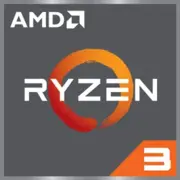AMD Ryzen 3 PRO 2200G

AMD Ryzen 3 PRO 2200G: A Budget APU for Office and Multimedia in 2025
An up-to-date review of a processor that still finds its fans
Key Features: Architecture, Process Technology, and Main Characteristics
The AMD Ryzen 3 PRO 2200G, released in 2018, remains a popular choice for budget PCs due to its well-balanced combination of price and functionality.
Architecture and Process Technology
- Codename: Raven Ridge.
- Process Technology: 14 nm (GlobalFoundries).
- Cores/Threads: 4 cores, 4 threads (no SMT support).
- Frequencies: Base — 3.5 GHz, turbo mode — up to 3.7 GHz.
- Cache: L3 — 4 MB.
- TDP: 35 W.
Integrated Graphics
Radeon Vega 8 (8 GPU cores, clocked up to 1100 MHz) provides basic performance for gaming and graphic work. For instance, in Dota 2 at Medium settings (1080p), you can achieve 40-50 FPS.
Performance
- Geekbench 6: 1000 (Single-Core), 2822 (Multi-Core).
- For comparison: Ryzen 5 3400G (4C/8T) scores about 1200/4500 in the same test.
Key Features
- Low power consumption (ideal for compact systems).
- Support for AMD SenseMI technologies and Secure Processor for data encryption.
Compatible Motherboards: Sockets and Chipsets
The Ryzen 3 PRO 2200G uses the AM4 socket, which provides a wide selection of motherboards.
Recommended Chipsets
1. A320: Budget option (e.g., ASUS Prime A320M-K, $60). No overclocking support.
2. B350/B450: For upgrades (e.g., MSI B450 Tomahawk Max, $90). Supports PCIe 3.0 and memory overclocking.
3. X370/X470: Excessive for this processor but suitable if planning to upgrade to Ryzen 5/7.
Important!
- Motherboards on 300 series chipsets may require a BIOS update (use Flashback feature if available).
- Avoid older revisions of motherboards — check compatibility on the manufacturer’s website.
Supported Memory Types
The processor works only with DDR4.
Recommendations
- Frequency: Optimal — 2666–3200 MHz. At 2933 MHz, Vega 8 shows a performance boost of up to 15% in games.
- Mode: Always use a dual-channel configuration (2×4 GB or 2×8 GB). For example, the Crucial DDR4-3000 kit (2×8 GB) at $45 will enhance iGPU performance.
- Latency: CL16 or lower (sets with timings 16-18-18-36 are preferred).
Limitations
Maximum capacity — 64 GB, but for office tasks, 8–16 GB is sufficient.
Power Supplies: Calculation and Recommendations
With a TDP of 35 W, the processor is not demanding in terms of power supply.
Scenarios
- Without a discrete graphics card: A power supply of 300–400 W is sufficient (e.g., be quiet! System Power 10 400W, $50).
- With a graphics card: For RX 6400 (75 W), choose a power supply of 450–500 W (Corsair CX450, $55).
Tips
- Don’t skimp on the power supply: an 80+ Bronze certification guarantees stability.
- Compact models are suitable for mini-PCs (FSP FlexGURU 300W, $60).
Pros and Cons of the Ryzen 3 PRO 2200G
Pros
- Energy Efficiency: Ideal for systems with limited cooling.
- Integrated Graphics: Replaces budget graphics cards in 2025 (e.g., GT 1030 costs $90, while Vega 8 is "free").
- Price: New units are priced at $80–100 (as of April 2025).
Cons
- 4 Threads: Multitasking is weaker than that of the Ryzen 3 3100 (4C/8T).
- Outdated Process Technology: Competitors on 10 nm (Intel) or 7 nm (AMD Ryzen 5000) are more energy-efficient.
- No PCIe 4.0: A limitation for next-gen SSDs.
Use Cases
Office Tasks
- Document editing, browsing (20+ tabs), video conferencing.
- Example: Build based on ASRock A320M-HDV ($65) + 8 GB DDR4.
Multimedia
- Streaming video (4K HDR via HDMI 2.0), light editing in Shotcut.
- Tip: Add an NVMe SSD (e.g., Kingston A2000 500 GB, $40).
Gaming
- eSports: CS2 — 720p/60 FPS, Overwatch 2 — 1080p/Low/50 FPS.
- Indie Games: Hollow Knight, Stardew Valley — no problems.
Comparison with Competitors
1. Intel Core i3-10100 (4C/8T):
- Pros: Better single-threaded performance (~1100 in Geekbench 6).
- Cons: Integrated UHD 630 graphics are 40% weaker than Vega 8. Price — $120.
2. AMD Ryzen 5 3400G (4C/8T):
- Vega 11 is 25% faster but costs $150 (new).
3. Intel Pentium Gold G7400 (Alder Lake, 2C/4T):
- Higher single-threaded performance, but 2 cores are a bottleneck.
Conclusion: The Ryzen 3 PRO 2200G wins in the budget segment thanks to its iGPU.
Practical Assembly Tips
1. BIOS: Update to the latest version before installing the processor.
2. Cooling: The box cooler is sufficient, but for quieter operation, take the Deepcool GAMMAXX 400 ($25).
3. Storage: An SSD is a must — even a SATA model (Crucial MX500) will reduce loading times.
4. Case: For HTPC, a Mini-ITX case (Fractal Design Node 202) will work well.
Final Verdict: Who Should Choose the Ryzen 3 PRO 2200G?
This processor is ideal if:
- Budget is limited ($200–300 for the whole build).
- Integrated graphics are needed for gaming or video work.
- Energy efficiency is important (home server, media center).
In 2025, the Ryzen 3 PRO 2200G is a solid compromise for non-demanding users who are not ready to pay extra for new models. Its main advantage is autonomy and minimalism without unnecessary costs.
Basic
CPU Specifications
Memory Specifications
GPU Specifications
Miscellaneous
Benchmarks
Compared to Other CPU
Share in social media
Or Link To Us
<a href="https://cputronic.com/index.php/cpu/amd-ryzen-3-pro-2200g" target="_blank">AMD Ryzen 3 PRO 2200G</a>